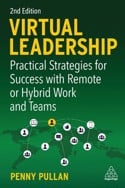Hybrid teams are more challenging to manage than purely virtual ones, but they can be successful - with the right leadership, explains Dr Penny Pullan MBCS.
In terms of technology, BCS members had it easy when lockdowns first struck. Compared to the general population, we tend to be comfortable with technology, so we were largely well-equipped to deal with new systems and software when working from home.
But grappling with virtual technology wasn’t the whole story. Leading dispersed people proved quite different, as did dealing effectively with virtual colleagues without being able to walk up to them for a quick catch up. Virtual working needed new, more facilitative ways of working. It needed virtual leadership!
The world is shifting again and we’re moving to a more hybrid way of working. For individuals, this offers the possibility of working much more flexibly: sometimes being located in the office when it suits and sometimes working remotely from home, or even a co-working space. This has the added bonus of saving time and cost spent on commuting and opening up possibilities not dreamed of before lockdowns, such as living further away from city centre offices.
For leaders, this means dealing with some people working remotely while others are together in the same office location. To complicate matters, the mix of who is in the office and who is working remotely is likely to change from day to day.
Hybrid is more complicated than everyone working in the office, or everyone working virtually! The equality and inclusion that came with everyone remote, with each of us in the same-sized rectangular boxes on screen, has long gone. Hybrid, as we are finding, is much more difficult to get right.
To use a football analogy, in hybrid there is no level playing field. Those who work remotely are too often out of sight - and out of mind. In meetings, they miss out on the nuances and dynamics of conversation in the room and they can’t catch up informally around the coffee machine or as people leave the meeting room. This proximity bias affects work in general, with remote workers more likely to miss out on promotions, key projects and bonuses.
So, what can we do to make hybrid ‘work’ and promote inclusion of all, in the new landscape of work that is emerging? We need a new style of working based on the facilitative, virtual leadership I have long espoused.
Let’s explore how this might be for hybrid, taking three aspects: hybrid meetings, hybrid work outside of meetings and, for those in leadership positions, leading hybrid teams. I will touch on each of these now, bringing insights from the new edition of my book: ‘Virtual leadership: practical strategies for success with remote or hybrid work and teams’ published by Kogan Page in March 2022.
Hybrid meetings
Design your meetings to encourage collaboration and participation from everyone, whether they are remote or in the office. Avoid side conversations between people in the meeting room and instead include everyone, wherever they are based. Remember that 60-90 minutes is quite long enough to be online, so build in plenty of breaks, which will help those in the room too.
Enhance interaction by using small groups for discussions. Let those together in meeting rooms have some in-person chat in groups, and use virtual breakout rooms for remote participants. Think ‘remote first’ when inviting questions or asking for input, which counteracts the tendency to forget virtual participants.
A crucial step in making hybrid meetings work is to ensure that everyone can see and hear each other. Clear audio is key. Consider the case of a meeting room with one central microphone. Here, the challenge is to pick up each individual speaker, which might mean moving the microphone from speaker to speaker.
To overcome this and promote equality, some organisations suggest everyone joins the meeting remotely. If multiple people join in close proximity to each other, there will be a nightmare of pickup and feedback. Encourage people to use headphones, with noise-cancelling microphones where they can and to mute when not speaking.
Another way of levelling the playing field in hybrid meetings is to make sure that there is something physical to represent each remote person in the meeting room. You could use a name tent or card, but why not use life size cartoon caricatures of each remote person propped up, one per chair around the table? Without this, it is far too easy for them to be forgotten as those in the room discuss freely amongst themselves.
Remember to continue to use good practices for virtual meetings, see for example, providing clarity through each of my Magic 6TM statements when you start up meetings, as explained in my previous ITNOW article, How to make workshops work, despite complications:
- 'We are here to...'
- 'Today, we will...'
- 'Our plan...'
- 'Who's doing what?'
- 'How we work together...'
- ‘What’s next?’
Hybrid work outside of meetings
Of course, most work happens away from meetings, so level the playing field there as well. Ensure that your remote colleagues are coping and have access to training and support with the tools you use to collaborate.
Check in with remote team members one-to-one and encourage them to join in with social gatherings, both of which can help to reduce isolation. You can also support them to gain access to people in the office when they have issues reaching these people themselves.
Hybrid leadership
If you’re a team leader, are you also working remotely some of the time? It really helps when those in charge are modelling how to be an effective, hybrid team member.
For you
Be part of something bigger, join BCS, The Chartered Institute for IT.
Be aware of how easy it is for remote workers in hybrid teams to disappear into the background. Treat people the same wherever they are, and arrange time to meet with people for informal catch-ups. Encourage virtual team members to stay visible: by offering ideas, helping colleagues out and volunteering perhaps.
‘Proximity bias’ is a built-in cognitive bias in humans, which means that we tend to assume that a team member in the office is more productive, or better for a new opportunity, or even more worthy of a bonus than another working remotely. Be aware and counteract this with real data, using objective measures to remove bias wherever you can.
With your team, come up with norms for communication: what will you communicate and how? What should each of you expect from one another? With fewer informal conversations, communication does need to be planned more. Choose effective tools for sharing information and updates around the team and which communications channels to use.
It’s important to watch out for an ‘us and them’ mentality, splitting those in the office from those who are remote. This is of course absolutely natural human behaviour, but it really doesn’t help team cohesion! Encourage team members to become better hybrid leaders themselves, perhaps by creating pairs of buddies: one an office worker and one a remote worker, to support and mentor each other.
In terms of inclusion, ensure you have fair policies, regarding people according to their output, not when or where they complete their work or any protected characteristic. Equality is a cornerstone for trust in virtual and hybrid teams. Visible fairness will build trust, benefiting every team member, wherever they work.
Coordinate working patters across the team so that people will be in the office together - remember that there is no point of someone commuting to the office for a day a week, if all of their team members work from home that day. If team members work flexibly, make sure that everyone knows who will be in the office and when.
In-person team time together can really help when welcoming new starters to your organisation. When you do get your team together in person, make the most of your time by focusing on relationship building, not watching presentations!
Remember that hybrid is more complicated than when everyone was virtual. Once lockdowns came to a close, people thought that moving to hybrid from remote would be a relief and a step back to ‘normal’. Instead, hybrid meetings turned out to be rather complicated, with more going wrong and lacking a level playing field. While things will go wrong, it’s not the end of the world as long as you keep improving. Do so by asking: ‘What went well?’ and ‘I wish that...’ learning as you go.
Summary
It’s so important to keep focused on inclusion and levelling the playing field to help you work effectively with others in a hybrid environment. I’ve given you a few introductory ideas to think about and apply. Now it’s over to you!
 About the author
About the author
Dr Penny Pullan MBCS has worked in virtual and hybrid ways since 9/11 forced her to kick-off her first global programme virtually. She’s the author of Virtual Leadership: practical strategies for success with remote or hybrid work and teams, the 2nd edition of her pandemic bestseller, published by Kogan Page in March 2022.
She has helped thousands of people to be effective in this new way of working, through her Virtual Leadership framework and tools. She is the founder of www.makingprojectswork.co.uk and is the author of five books, including Making workshops work - creative collaboration for our time.

















